Up there with the loveliest capitals in the world, Prague is a city of Baroque palaces, Gothic spires, stately squares, winding cobblestone streets and a castle of simply colossal proportions.
Under Holy Roman Emperor, Charles IV in the 14th century this was the third largest city in Europe, behind only Rome and Constantinople.
The impact of Charles IV on this city by the Vltava River can still be felt today, in the majestic Charles Bridge, the lofty spires of St Vitus Cathedral and the dramatic expanse of Wenceslas Square, where key moments in Czech and European history have played out.
1. Prague Castle
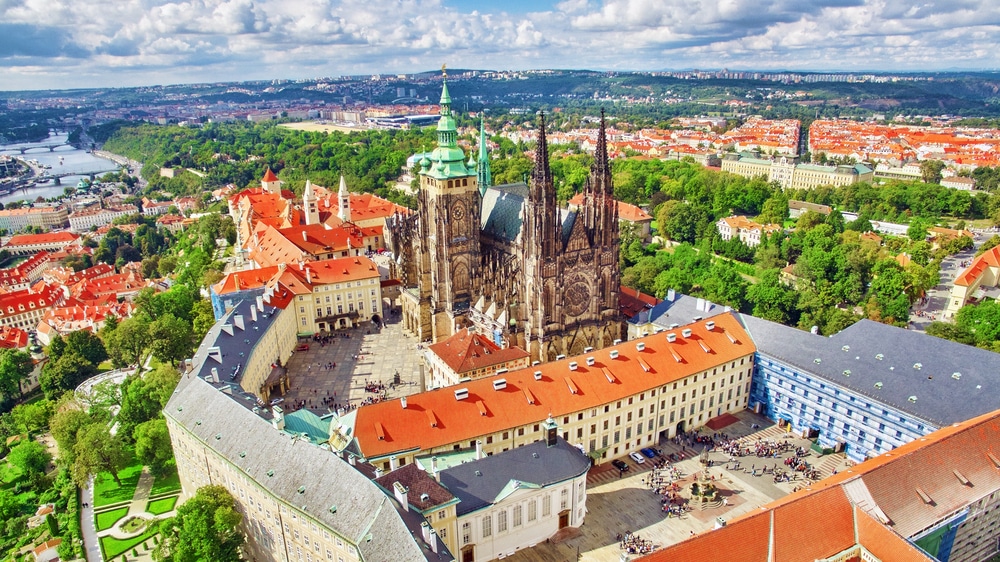 Source: V_E / shutterstock
Source: V_E / shutterstockOfficially the largest historic castle complex in the world, the UNESCO-listed Prague Castle is a vast assortment of palaces, courtyards, churches, halls, towers and gardens reaching back to the 9th century.
The castle’s footprint is giant, at 570 metres long and 130 metres wide, high above the left bank of the Vltava so the spires of St Vitus Cathedral are a constant reference point for the city.
A seat for the Kings of Bohemia, Holy Roman Emperors and modern presidents, the complex was built over many hundreds of years and has architecture in every style from Romanesque to Baroque.
The ticket for the main circuit will get you into St Vitus Cathedral, the Old Royal Palace and the exceptionally old St George’s Basilica, which has Romanesque stonework behind its Baroque facade.
2. Charles Bridge
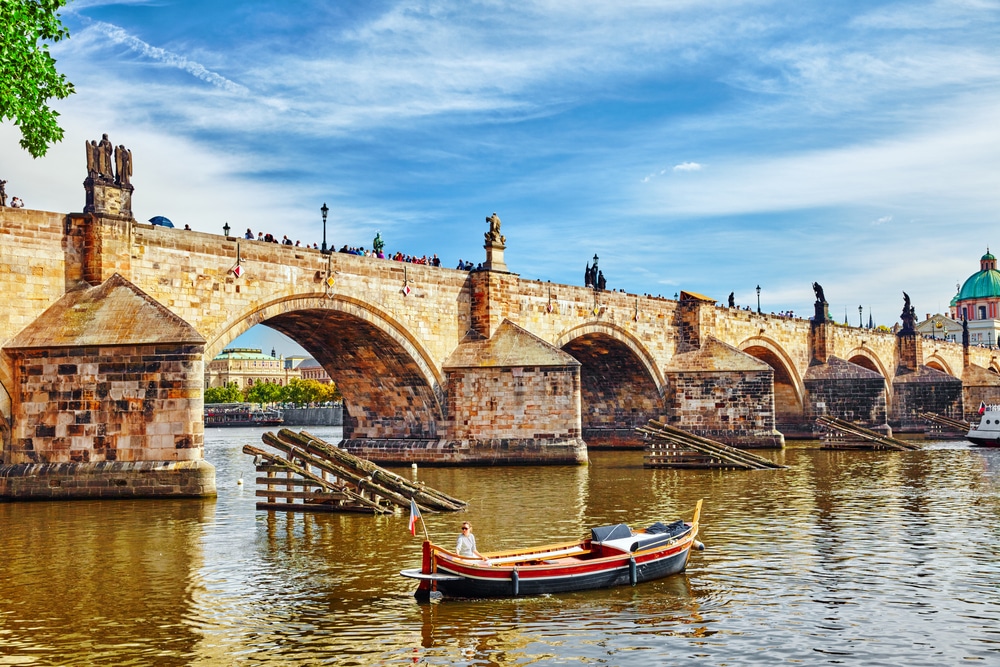 Source: V_E / shutterstock
Source: V_E / shutterstockReady in 1402, this staggering piece of Medieval engineering took 45 years to complete, and helped cement Prague’s position as a trading centre linking Eastern and Western Europe.
Just over half a kilometre in length and built from dusky Bohemian sandstone, the Charles Bridge carries you from the Old Town to the Lesser Town at the foot of Prague Castle.
The crossing is named for Holy Roman Emperor Charles IV who ordered its construction, and is reinforced by three defensive towers.
Two of these are on the Lesser Town side, while the dominant Old Town Bridge Tower heralds the entrance on the right bank and was intended as a triumphal arch along the coronation route towards St Vitus Cathedral at Prague Castle.
Sitting on the balustrades are 30 Baroque statues, most erected between 1683 and 1714 and depicting saints and the Stations of the Cross.
A basic ticket for Prague Castle will also grant you entry to the Charles Bridge Museum, shedding light on the construction of this stunning landmark.
3. Old Town Square
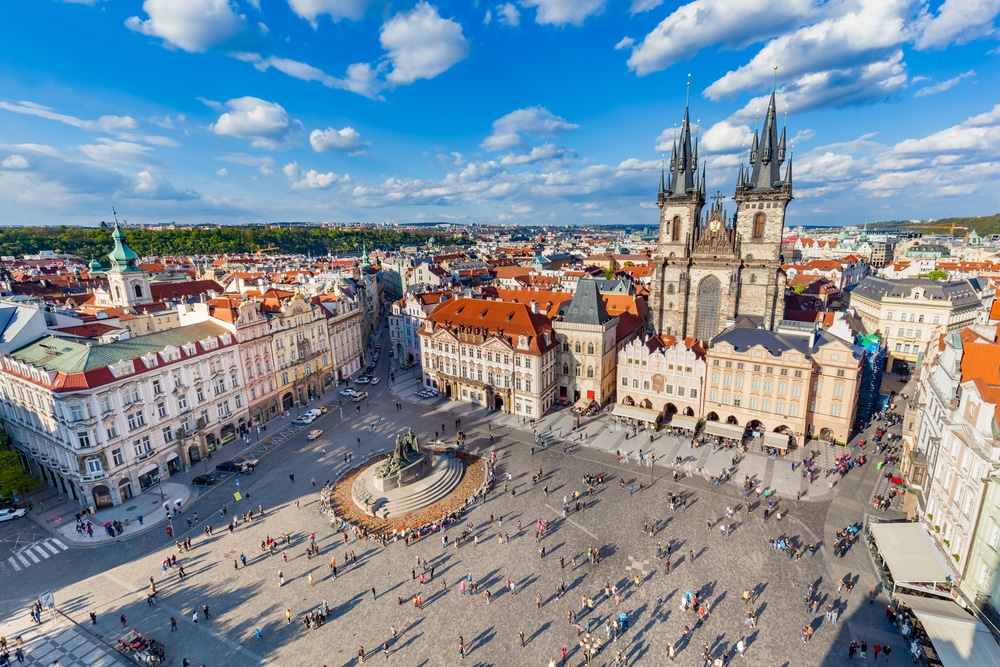 Source: PHOTOCREO Michal Bednarek / shutterstock
Source: PHOTOCREO Michal Bednarek / shutterstockThere’s grandeur and history at every turn on the oldest and most significant square in the historic centre of Prague.
For hundreds of years starting in the 900s, this was a place of commerce at a crossroads in international trade routes.
A few of the attractions on this list can be found on or near the Old Town Square, and you can just soak up the scene from one of the many cafe and restaurant terraces on the south and east sides.
The oldest buildings on the square cropped up in the 12th and 13th centuries, and while most of the facades are Baroque, the foundations and vaults within are often Romanesque and Gothic.
It was here during a Protestant uprising in 1618 that 27 prominent Czechs were executed by the House of Habsburg, in an event that helped spark the Thirty Years’ War.
By the Old Town Hall you can make out 27 crosses laid in their memory. There’s also a monument for the theologian and religious reformer, Jan Jus, burned at the stake for his beliefs in 1415, sparking the Hussite Wars of 1419-1434.
4. Old Town Hall with Astronomical Clock
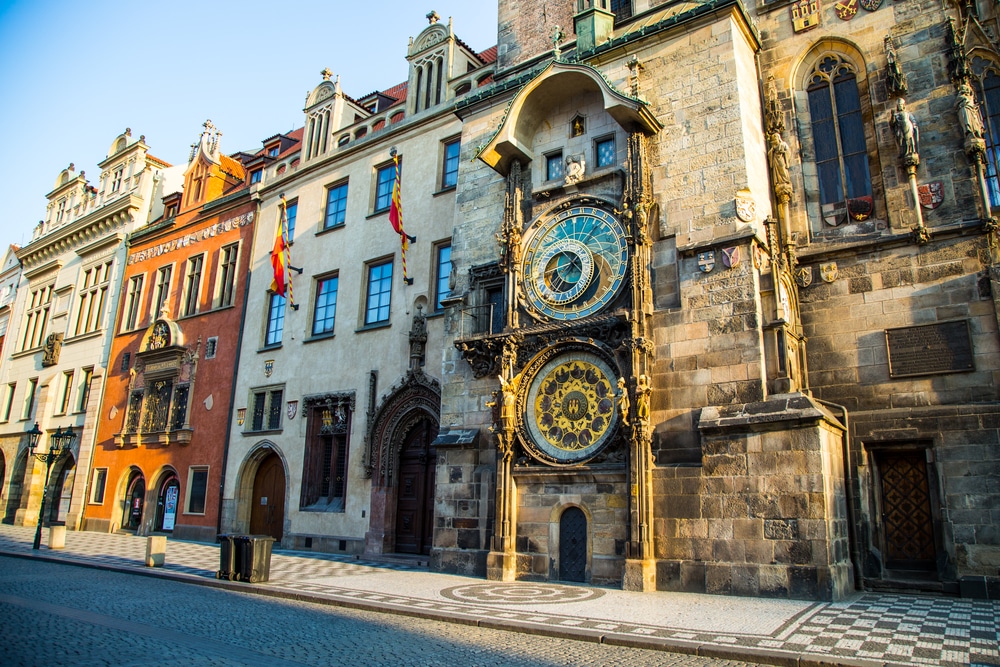 Source: Ilyshev Dmitry / shutterstock
Source: Ilyshev Dmitry / shutterstockThe Town Hall on the south-west corner of the square sets the scene for the postcard image for Prague.
The oldest portion of the building has stood here since 1338, and directly below the beautiful Gothic tower is a three-storey symbol for Prague: The Astronomical Clock (Orloj) was installed here in 1410, and is claimed to be the oldest clock in the world still operating.
The astronomical dial and the clock’s mechanism date from that time, while the wooden statues and figures of the Apostles came later, in the 17th and 18th century. The Apostles make an appearance on the hour between 09:00 and 23:00.
Below the astronomical dial is the zodiacal ring, added in 1865. There’s a tourist information centre inside the Old Town Hall, and for a fee you can take a look inside the old meeting halls, the 14th-century chapel, the underground vaults and make your way to the top of the tower to survey the square.
5. St Vitus Cathedral
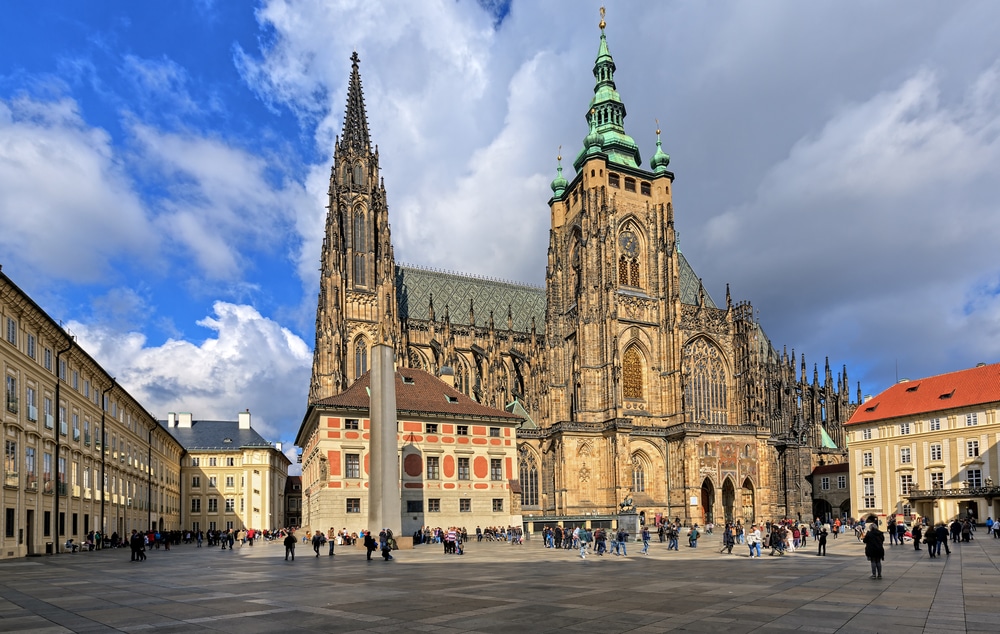 Source: fotorince / shutterstock
Source: fotorince / shutterstockThe largest place of worship in Prague is in Prague Castle’s mosaic of buildings and is impossible to miss for its contrasting Gothic and Baroque spires.
The third temple on this site, St Vitus Cathedral, was begun in 1344 under the reign of Charles IV, but the project ground to a halt in 1419 at the start of the Hussite Wars. The building would remain incomplete for more than 500 years until a society was set up to finish the work in the 19th century, finally reaching its conclusion in 1929.
A long line of Czech kings and queens were crowned in this monument, and before the high altar is the Royal Mausoleum below which are the tombs of royalty, while the chancel’s radiating chapels are the burial place for several Czech patron saints and archbishops.
Here, the cathedral’s outstanding feature is the richly decorated St Wenceslas Chapel, dating to the 14th century and lined with precious stones and murals from that time depicting the Passion cycle. An upper band of painting represents the life of St Wenceslas and dates from the start of the 16th century.
6. Malá Strana (Lesser Town)
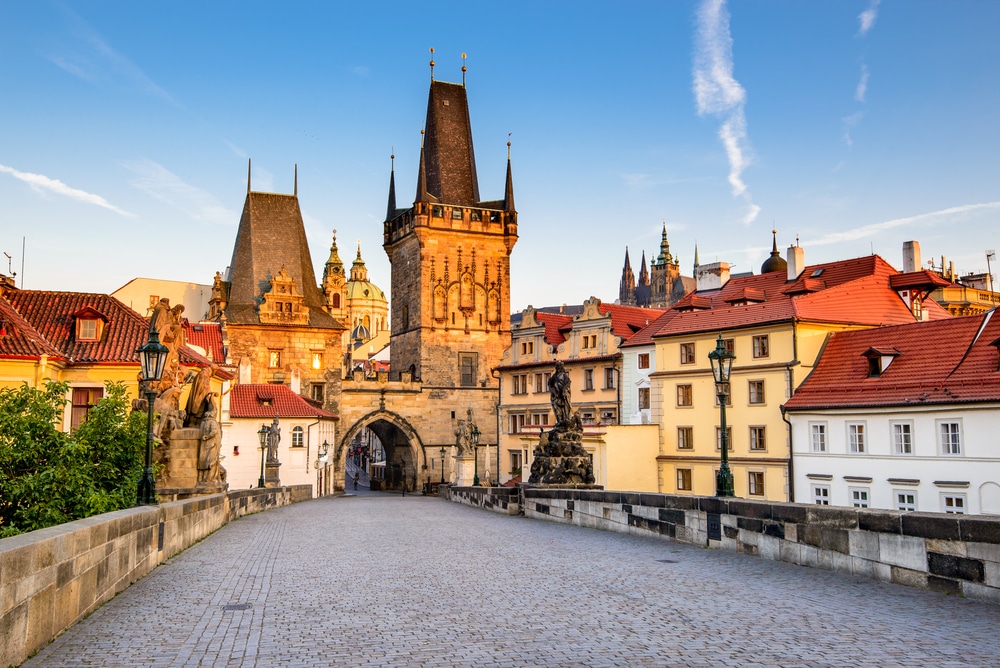 Source: cge2010 / shutterstock
Source: cge2010 / shutterstockAfter crossing the Charles Bridge on the way to Prague Castle you’ll find yourself in one of the prettiest and best-preserved parts of the city.
Bestowed with privileges as a royal town, Malá Strana was a separate city up to 1784 and is a thrill to explore with cobblestone streets flanked by refined gardens, burgher houses, churches, aristocratic palaces and imposing buildings for government institutions.
This corner of Prague has a history reaching back to the 13th century, but almost all of the facades are in the Baroque style after a fire claimed much of the cityscape in 1541. Many of the buildings have much older architecture, as you’ll see in the vaulted cellars of the inns and restaurants here.
The largest construction from the Baroque period is Wallenstein Palace (1623-1630), now housing the Senate of the Czech Republic. Presiding over the palace’s long Italian-style garden are the three monumental arches of the open Sala Terrena pavilion.
7. St Nicholas Church
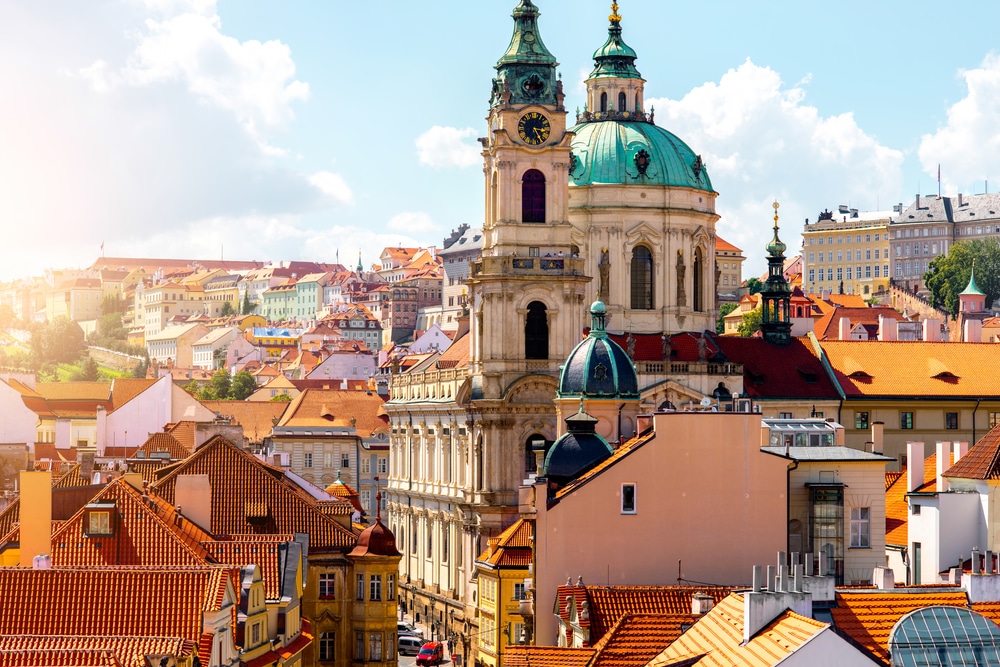 Source: RossHelen / shutterstock
Source: RossHelen / shutterstockPrague’s most sumptuous Baroque building is a church of monumental dimensions, with a dome and belfry that define the silhouette of the Malá Strana.
St Nicholas Church was intended as a Jesuit temple, built in the first half of the 18th century and taking design cues from Rome’s Church of the Gesù, as well as Les Invalides in Paris for the interior.
A word on the magnificent dome, which has a diameter of 20 metres and a ceiling almost 70 metres above the floor of the church.
Go in to be wowed by the ostentatious Rococo design, brimming with statuary, gilded stucco work, marble effect and frescoes by the day’s leading painters, like František Xaver Palko and Jan Lukáš Kracker.
The separate belfry is actually owned by the city and not the church, and has a viewing gallery up 65 metres and 215 steps, while the church is a magnificent venue for classical concerts in the evening.
Website: http://www.stnicholas.cz/
8. Petřín
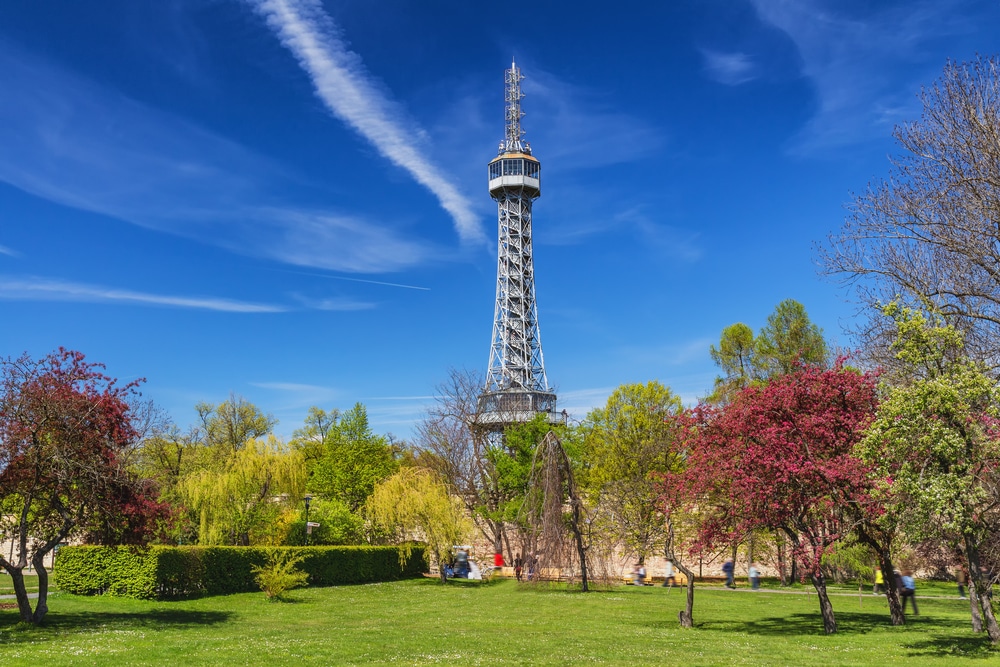 Source: DaLiu / shutterstock
Source: DaLiu / shutterstockThe long ridge of this 327-metre wooded hill dominates the city from the left bank of the Vltava.
The name Petřín is thought to come from the hill’s rocky terrain, and the stone for Prague’s early churches and the first bridge over the Vltava was quarried from here.
Walking in the parks that cover most of Petřín it will be easy to spot the remnants of a marl wall raised in the 1360s by Charles VI to protect Prague Castle and the Malá Strana.
At the hill’s summit is a steel framework lookout tower, 63.5 metres tall and built in 1891. Hiking to the hilltop, pausing occasionally to admire the vista, is a fine way to while away an hour or so.
But if you’re pushed for time there’s a funicular running from the Malá Strana, which was first installed in 1891. Also at the top is a picture perfect rose garden and the Štefánik Observatory, which opened in 1928.
9. Old Jewish Cemetery
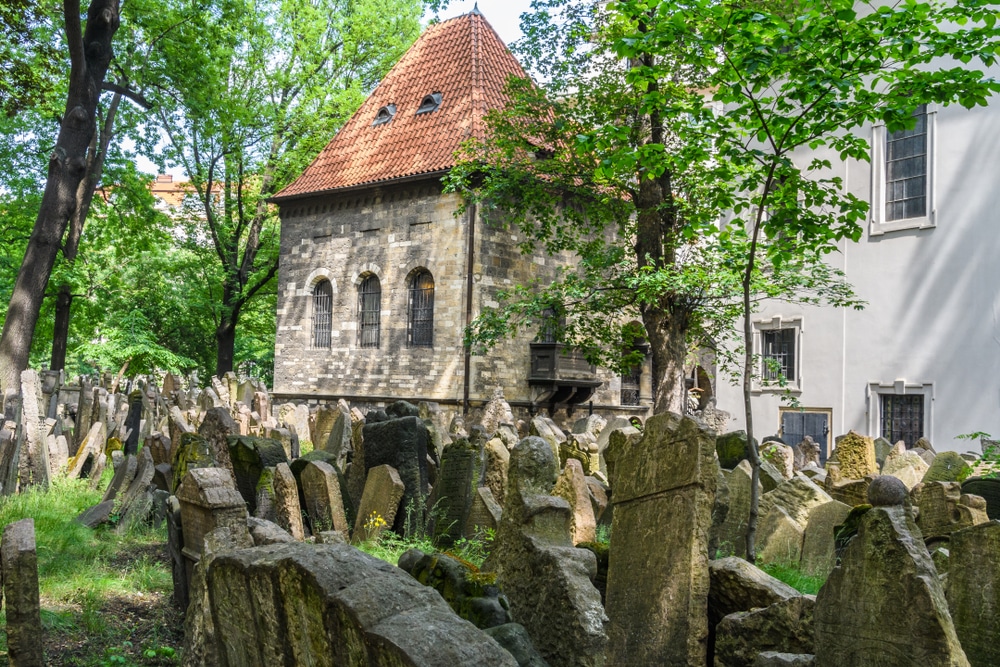 Source: Gabor Kovacs Photography / shutterstock
Source: Gabor Kovacs Photography / shutterstockAn obligatory visit in Prague’s Jewish Town is the world’s oldest preserved Jewish cemetery, founded in the first half of the 15th century.
The last burial took place in 1787, just after Holy Roman Emperor Joseph II had banned burials within the city walls because of hygiene.
There are roughly 12,000 tombstones in the Old Jewish Cemetery, but with graves layered up to ten deep it is estimated that there were 80,000 burials here during the site’s 350-year history.
An audio guide will help you decipher the symbols on the gravestones, and you can locate the burial place of some key historical figures.
There’s the Talmudic scholar, Judah Loew ben Bezalel (d. 1609), renowned for his works on Jewish philosophy and mysticism, and Mordecai Meisel (d. 1601), the mayor and philanthropist who helped develop the Jewish town. Rabbi David Oppenheim meanwhile (d. 1736) amassed a book collection that continues to make up a big part of the Hebrew section at Oxford University’s Bodleian Library.
https://www.jewishmuseum.cz/en/explore/sites/old-jewish-cemetery/
10. Letná Park
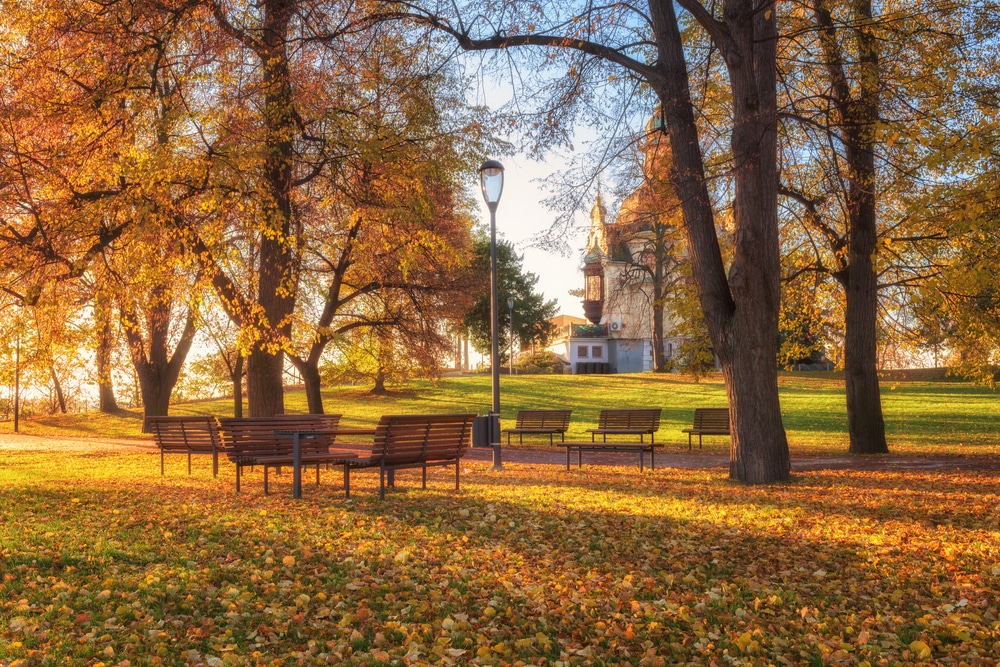 Source: Uhryn Larysa / shutterstock
Source: Uhryn Larysa / shutterstockThis hillside park rises over the steep bank of the Vltava, just as it bends away from Old Town and Malá Strana. In the Middle Ages the land on Letná Park was a camp for armies in summer, valued for its strategic position allowing you to look right along the river for miles and across to the Old Town.
Landscaped in the 19th century, it’s a gorgeous place to stretch your legs, with lots of mature trees, flowerbeds, lawns and a spacious beer garden on the east side with a fabulous view.
Seek out the neo-Baroque Hanavský Pavilion, erected for the Jubilee World Fair in 1891, while the carousel close by dates from 1892 and has been here since 1894. Another monument up here is a giant metronome, set on a grand pedestal that until 1991 held a statue of Stalin.
11. Wenceslas Square
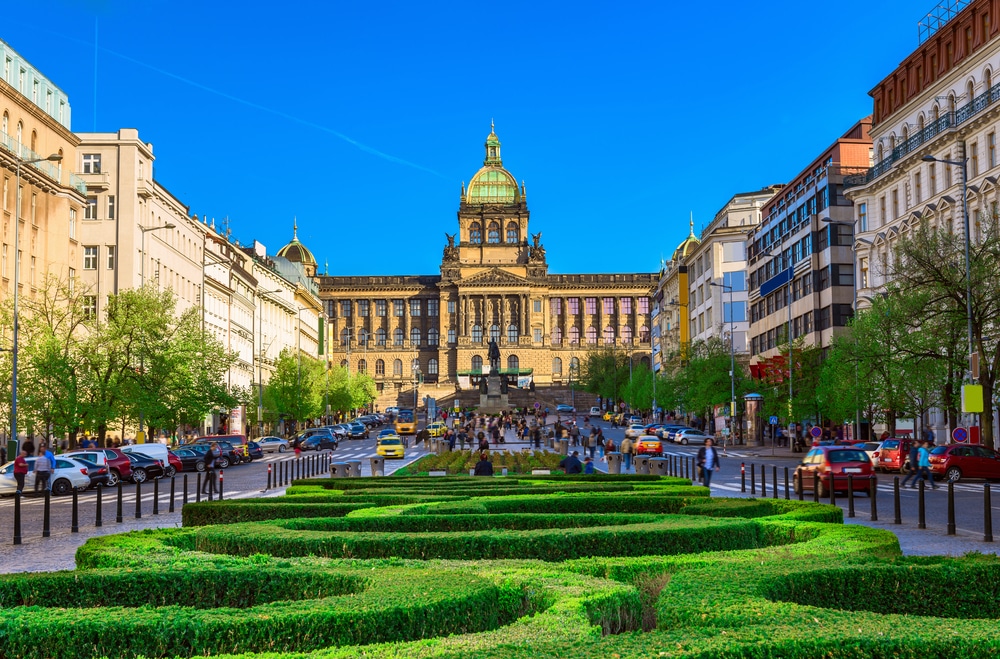 Source: Catarina Belova / shutterstock
Source: Catarina Belova / shutterstockBreaking free of the cobblestone tangle of the Old Town is a monumental square harking back to the creation of the New Town by Charles IV in the middle of the 14th century. Back then this was the city’s horse market, which explains the giant proportions at 750 metres long and 60 metres wide.
Lined with museums, flagship stores, restaurants, boutiques and hotels, Wenceslas Square is Prague’s commercial and administrative hub.
This has also been the scene for some momentous events in the last century or so. Prominent Czech writers gathered here to read the declaration of Czechoslovakian Independence in front of the statue of Saint Wenceslas in 1918.
Jan Palach later set himself alight at this place to protest the Warsaw Pact Invasion of Czechoslovakia in 1969, and massive demonstrations took place on the square during the Velvet Revolution in 1989.
12. Klementinum
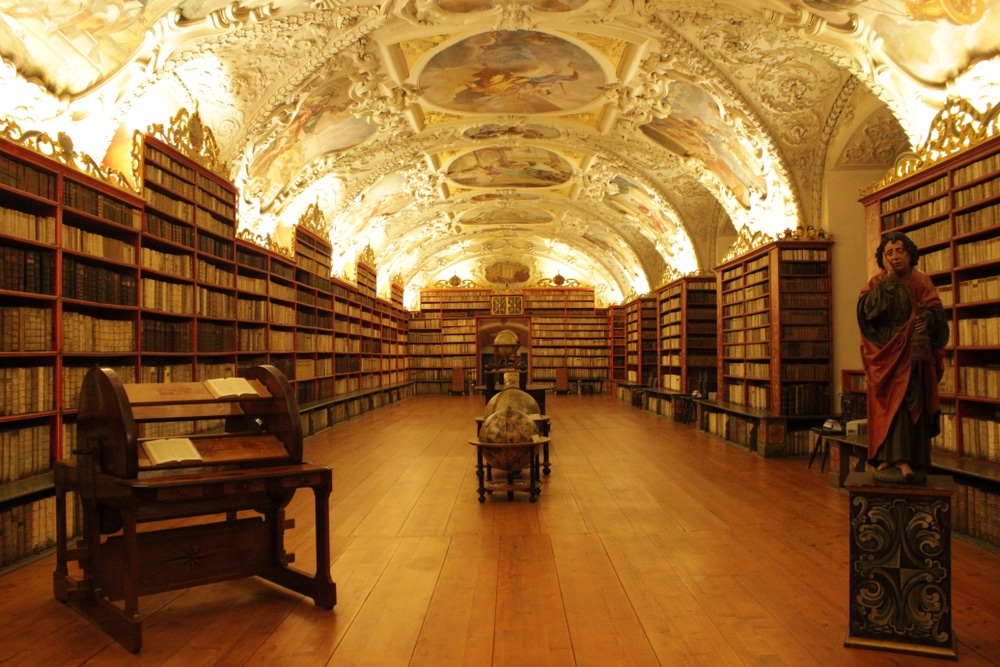 Source: De Kam / shutterstock
Source: De Kam / shutterstockThe largest architectural complex in the Old Town has a historical importance that can’t be overstated.
Since Medieval times, many of Europe’s foremost scientists, philosophers and musicians have plied their trade in this warren of buildings and courtyards. The Klementinum has a special place in the history of meteorology in particular, compiling local observations since the middle of the 18th century.
The site dates from the 1200s, but much of the elaborate architecture is from the late-1500s to the mid-1700s when a Dominican convent was transformed and enlarged by the Jesuits. You can sign up for a guided tour, which takes just under an hour.
In that time you’ll see some wonderful sights: There’s the 18th-century Mirror Chapel, flush with carvings and frescoes, and with an organ played by Mozart.
The opulent Baroque Library, home of the Czech National Library, holds more than 20,000 volumes, and you can climb the 172 steps to the top of the Astronomical Tower, where those meteorological measurements have been collected for generations.
Website: https://www.klementinum.com/
13. Church of Our Lady before Týn
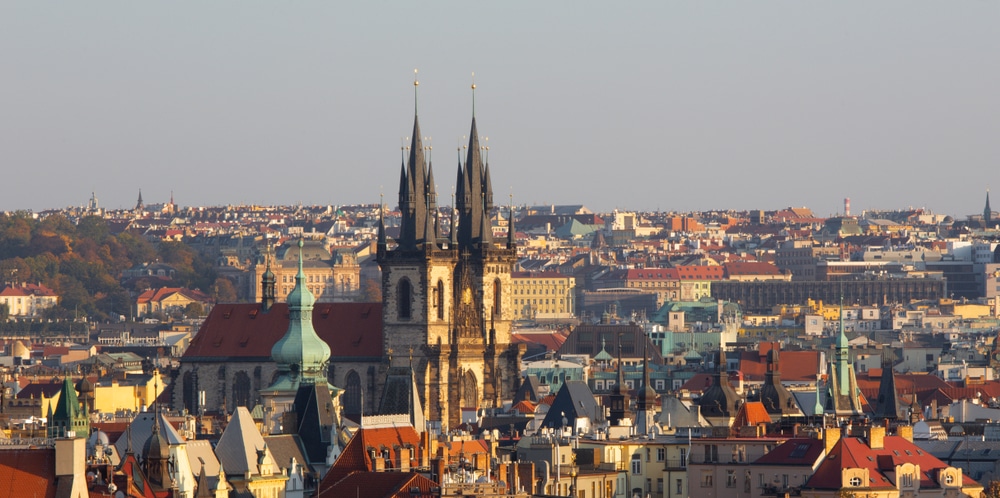 Source: Renata Sedmakova / shutterstock
Source: Renata Sedmakova / shutterstockIntegral to the Prague cityscape, this Gothic church is just off the east side of the Old Town Square. The Church of Our Lady before Týn is easily recognised by its pair of towers, both topped by a whole mass of corner spires.
Mostly Gothic, with Renaissance and Baroque fittings inside, this monument was constructed between 1350 and 1510.
On your visit, be sure to seek out the large Gothic baptistery from 1414, the tomb of the 16th-century astronomer Tycho Brahe (1546-1601), as well as the Baroque paintings by Karel Škréta (1610-1674) in the high altar and adorning an earlier Gothic stone baldaquin carved in the late-15th century.
Another treasured Baroque fixture is the organ from the 1670s, among the three oldest preserved organs in the city.
14. Vyšehrad
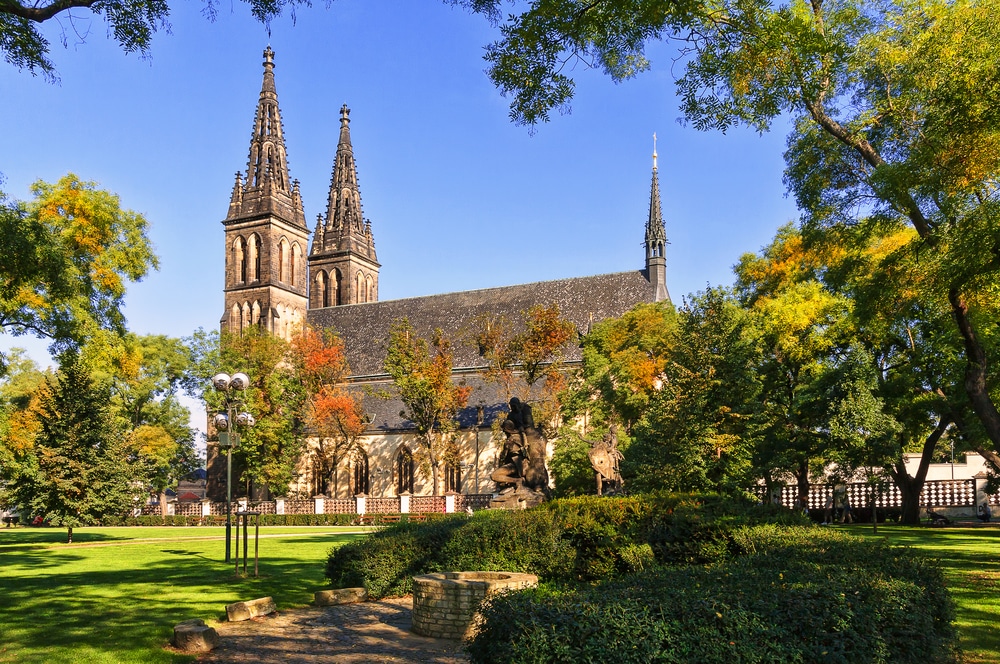 Source: Vladimir Sazonov / shutterstock
Source: Vladimir Sazonov / shutterstockRemoved from Prague’s historic centre, this castle stands on a rocky spur a couple of kilometres up the Vltava.
The fortification goes back at least as far as the 10th century, and is long rumoured to have been the location for the original settlement that grew into Prague. Vyšehrad’s main role was to defend the southern approach to the city, but grew in status in the High Middle Ages after the royal seat was transferred here from Prague Castle in the reign of Vratislaus II of Bohemia (1032-1092).
The fortress was remodelled in the Baroque style in the middle of the 17th century when it became a training ground for the Austrian Army. The twin spires of the Basilica of Sts Peter and Paul can be seen for miles. This building has been here since the 1100s, and was given a neo-Gothic makeover in the 19th century.
The adjoining cemetery is the burial place for a long roll-call of Czech cultural figures, including Antonín Dvořák.
There are lots of little monuments to look out for, like the 11th-century Romanesque Rotunda of St Martin, as well as fortified gates, the 14th-century Burgrave’s House, a Gothic cellar and a guard tower repurposed as a gallery.
Website: https://www.praha-vysehrad.cz/
15. Lobkowicz Palace
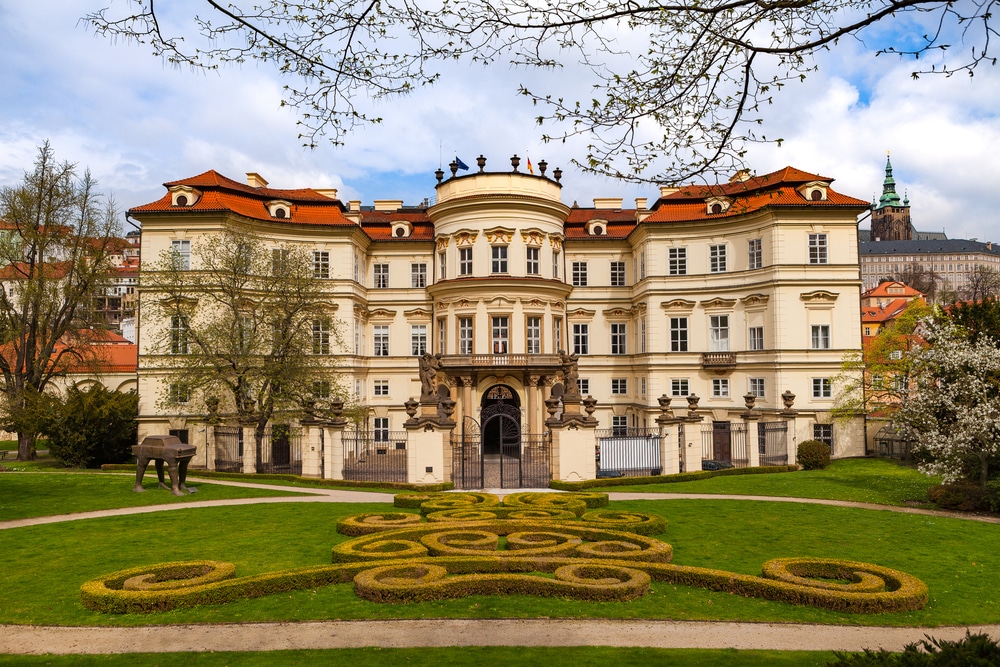 Source: yegorovnick / shutterstock
Source: yegorovnick / shutterstockPart of Prague Castle, this palace has been standing in some form since the 16th century, while much of its architecture dates from a Baroque redesign by Italian architect Carlo Lurago (1615-1684).
Apart from a hiatus in the 20th century Lobkowicz Castle has belonged to the namesake family for more than 400 years. In the Second Defenestration of Prague (1618), which helped kick off the Thirty Years War, the governors Slavata and Martinice took refuge from the Protestants in the Lobkowicz Palace after being thrown out of the window of a wing of the Old Royal Palace.
The building houses the Lobkowicz Collection, the oldest and largest private art collection in the Czech Republic, made up of painting, military equipment, invaluable sheet music and decorative arts.
Among the 1,500 paintings are pieces by Rubens, Velázquez, Veronese, Canaletto, Lucas Cranach the Elder and Younger and Pieter Brueghel the Elder and Younger.
Website: https://www.lobkowicz.cz/
16. Prague National Theatre
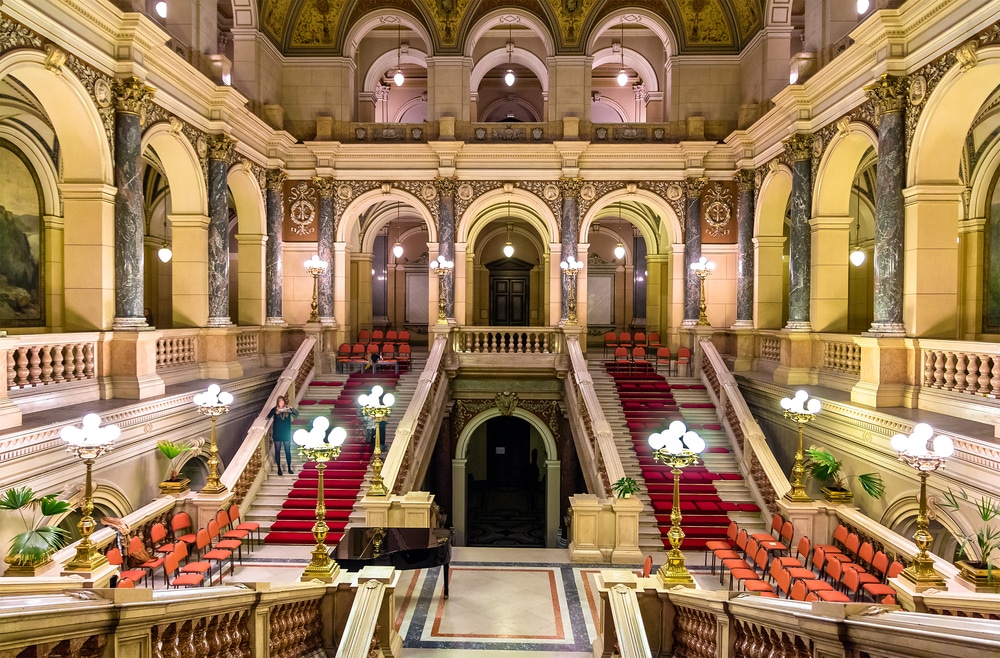 Source: Leonid Andronov / shutterstock
Source: Leonid Andronov / shutterstockWith its gleaming gold-crested roof, the spectacular neo-Baroque National Theatre steals your gaze just upriver from the Charles Bridge.
Vital because of both its bold architecture and because of what it means to Czech culture, this is the country’s most representative stage for opera, ballet and drama.
The National Theatre opened its doors in 1881 after 13 years of construction, but was almost razed by fire after just 11 performances. The subsequent rebuild was funded by a national campaign.
You can take an hour-long guided tour of the building designed by Josef Zítek. You’ll get to see the auditorium and stage of course, but part of the joy is visiting the various lounges and assembly halls replete with painting and sculpture by preeminent 19th-century Czech artists, from Bohuslav Schnirch to František Ženíšek, Václav Brožík, Mikoláš Aleš and Josef Václav Myslbek, to name a few.
Website: https://www.narodni-divadlo.cz/
17. Convent of St Agnes
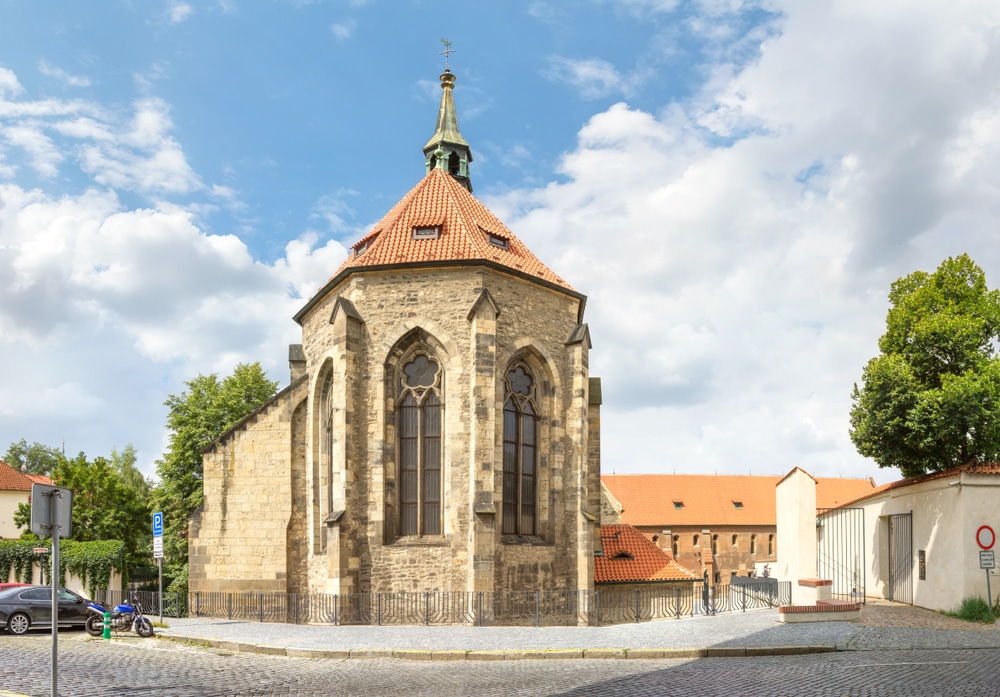 Source: Belikart / shutterstock
Source: Belikart / shutterstockIn the Old Town on the right bank of the Vltava stands one of the city’s finest pieces of Medieval Gothic heritage.
The Convent of St Agnes was founded in 1231 at the behest of Agnes, sister of Wenceslas I, who became the abbess here. Work continued through the 13th century, as the convent became the burial site for the Přemyslid family, beginning with the mausoleum of Wenceslas I in 1253.
The site later passed between different orders and fell into disrepair in the 19th century until a renovation at the turn of the 20th century. A guided tour will point out the marvellous Gothic elements in the cloister, kitchen, refectory, chapter house and chapels and churches of St Francis and St Salvator that have made it to the present day.
And as the convent is now in hands of the Czech National Gallery it’s an ideal stage for a permanent exhibition of Medieval Art from Bohemia and Central Europe, with pieces by Lucas Cranach the Elder (1472-1553).
Website: https://www.ngprague.cz/en/about/buildings/convent-of-st-agnes-of-bohemia
18. Old Royal Palace
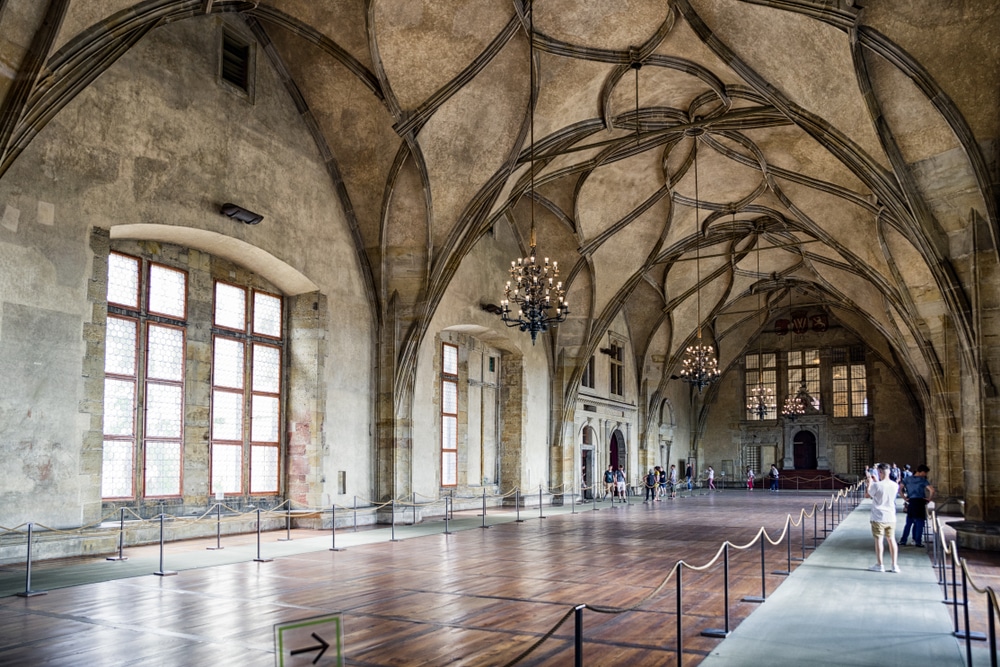 Source: Jaroslav Moravcik / shutterstock
Source: Jaroslav Moravcik / shutterstockIncluded in the full admission price to Prague Castle is the historic central portion of the southern wing, seat of the Czech princes and kings from the 900s to the 1500s.
There are layers of history at the Old Royal Palace, but most of the surviving architecture is Gothic, like the must-see Vladislav Hall.
Constructed between 1493 and 1502, the hall was the largest secular space in the city at the time, and an architectural feat for its vaults that rise 16 metres over the floor. Vladislav Hall continues to be used for Czech state functions.
Downstairs in the Gothic vaults is the permanent exhibition for the castle, introducing you to the thousand-year history of both this monument and the city around it.
The information boards here are matched with compelling artefacts like the 13th-century funerary crown of Ottokar II of Bohemia and the 10th-century armour and helmet of St Wenceslas.
19. Spanish Synagogue
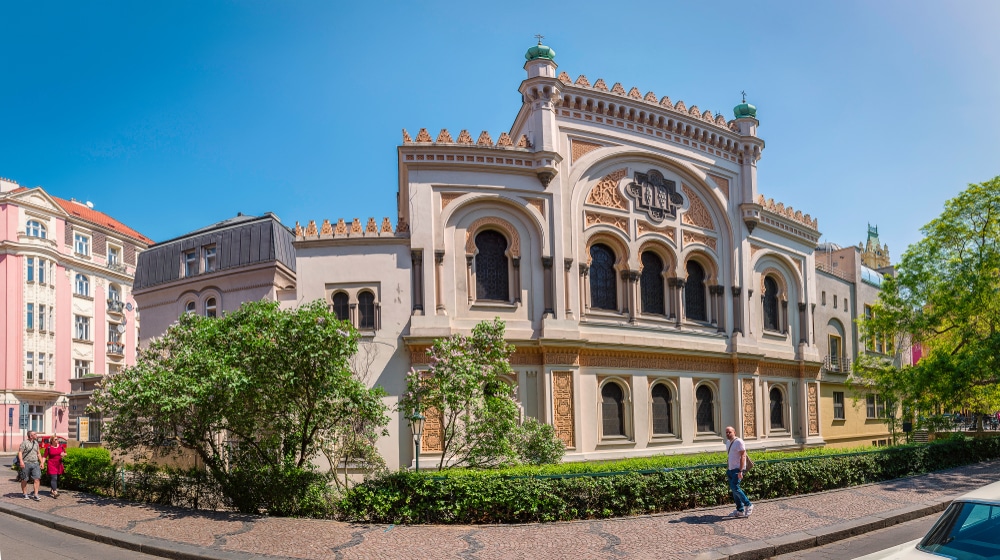 Source: OlegGr / shutterstock
Source: OlegGr / shutterstockIn the care of the Jewish Museum of Prague, the beautiful Spanish Synagogue dates to 1868 and was built for the city’s Reform congregation.
The current building, held as one of Europe’s finest synagogues, was built in a highly decorative Moorish Revival style on the site of the Altschule, founded in the 1100s and thought to be the oldest synagogue in the Jewish Ghetto.
The building is on two storeys with galleries overlooking the nave on three sides. Look up at the intricate mouldings in the dome, as well as the Star of David pattern in its stained glass. This pattern can also be seen in the sublime window in the east wall, ringed with delicate arabesques and set above an extremely ornate Torah ark.
The Spanish Synagogue was renovated in 1998 and houses a museum recalling the history of the Jewish community in Bohemia and Moravia, beginning with the 18th-century reign of the enlightened Joseph II, Holy Roman Emperor,
Website: https://www.jewishmuseum.cz/en/explore/sites/spanish-synagogue/
20. Rudolfinum
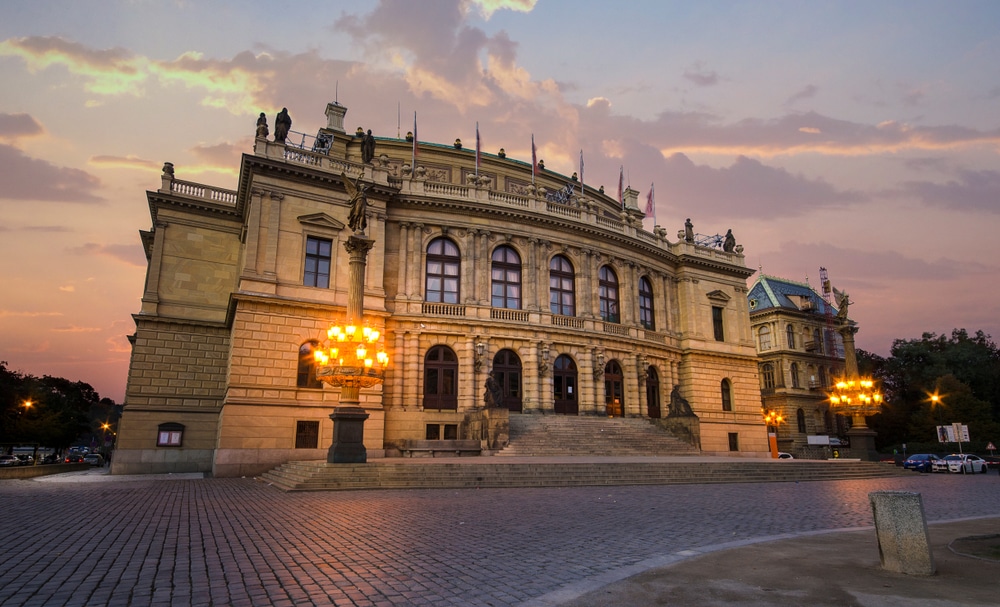 Source: Mitzo / shutterstock
Source: Mitzo / shutterstockThe seat of the Czech Philharmonic Orchestra is a palatial neo-Renaissance building right on the Vltava.
Opened in 1885, the Rudolfinum was conceived as a multi-faceted arts venue, with an auditorium but also a museum and gallery for visual arts. The main auditorium is named for Antonín Dvořák who conducted the Czech Philharmonic for the venue’s first concert in January 1896.
Famed for its acoustics, this hall is an anchor for the annual Prague Spring International Music Festival. Since 1994 the Rudolfinum has also resumed hosting temporary exhibitions for contemporary art.
A handful of the artists featured over the last three decades are Andy Warhol, Ana Mendieta, David Claerbout and Arthur Jafa. For a peek behind the scenes, you can book a guided tour, which will show you to spaces off limits like the rooftop, the Conductor’s Lounge and the Presidential Lounge.
Website: https://www.rudolfinum.cz/
21. Prague Zoo
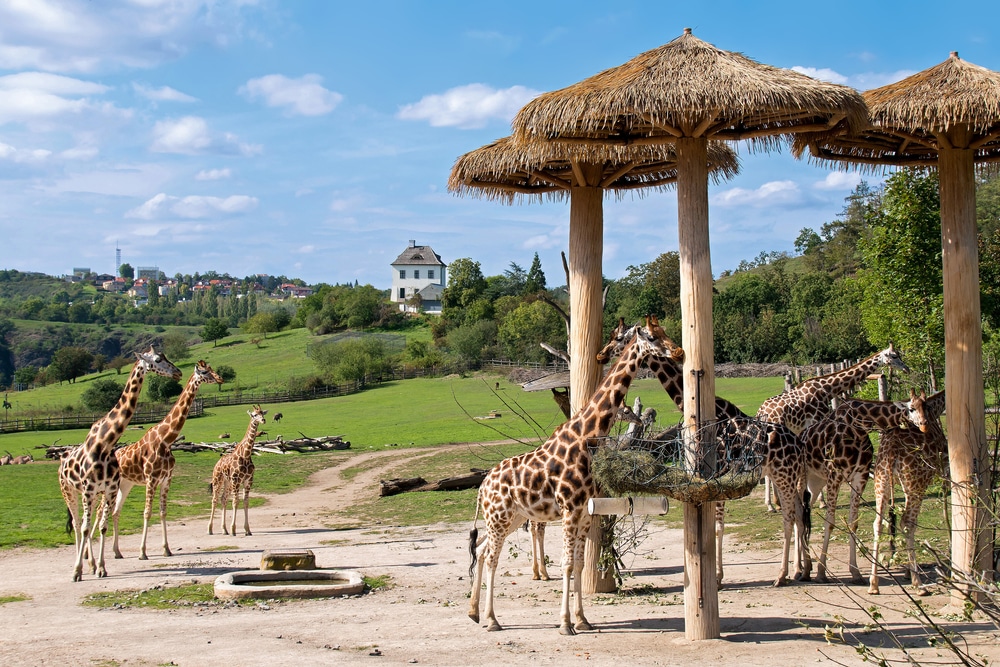 Source: Pritykin_Nikita / shutterstock
Source: Pritykin_Nikita / shutterstockNested in a meander in the Vltava, Prague Zoo is often counted among the best zoos in the world.
This has a lot to do with the location, in steep and spacious parkland laced with more than ten kilometres of walking trails. There are more than 670 species here, in jaw-dropping habitats and pavilions designed to resemble their ecosystems as closely as possible.
These are constantly being updated, and there’s always something new to check out. Take for example the rugged Darwin’s Crater, which opened in 2020, presenting the fauna and flora of Australia and one of the few places in Europe where you can see Tasmanian devils.
The Velemlokárium is a highlight, for its five massive terrariums where you can study the world’s largest amphibian, the Chinese giant salamander. All set up to help this endangered species breed, it’s the first facility of its kind in the world.
A word too on the Indonesian Jungle, one of the largest zoo pavilions in the world, recreating rainforest, mangrove and river habitats and housing species like Komodo dragons and Sumatran orangutans.
Website: https://www.zoopraha.cz/
22. Strahov Monastery
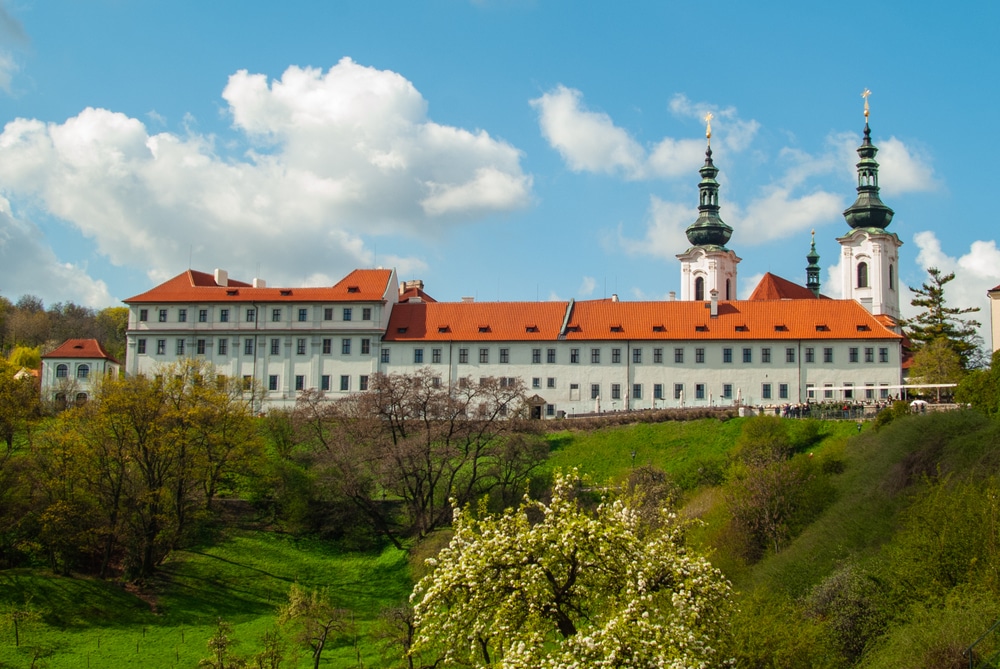 Source: Sarfoto / shutterstock
Source: Sarfoto / shutterstockThe towers of this Premonstratensian abbey can be seen from some distance on the far side of the Petřín hill.
With sweeping views over the Malá Strana and across the Vltava, Strahov Monastery was established in 1143 and has a blend of Gothic and Baroque architecture, with elements dating back 800 years.
As an institution this was a centre of culture and learning for hundreds of years, demonstrated by one of the region’s largest collections of Gothic and Rudolfina Art (late-16th and early-17th century), and a spellbinding library containing more than 200,000 volumes and 3,000 manuscripts.
There you can cast your gaze on the exuberant stucco work and frescoes of the Theological Hall (1720s) and the Philosophical Hall (1780s).
Website: https://www.strahovskyklaster.cz/
23. The Powder Tower
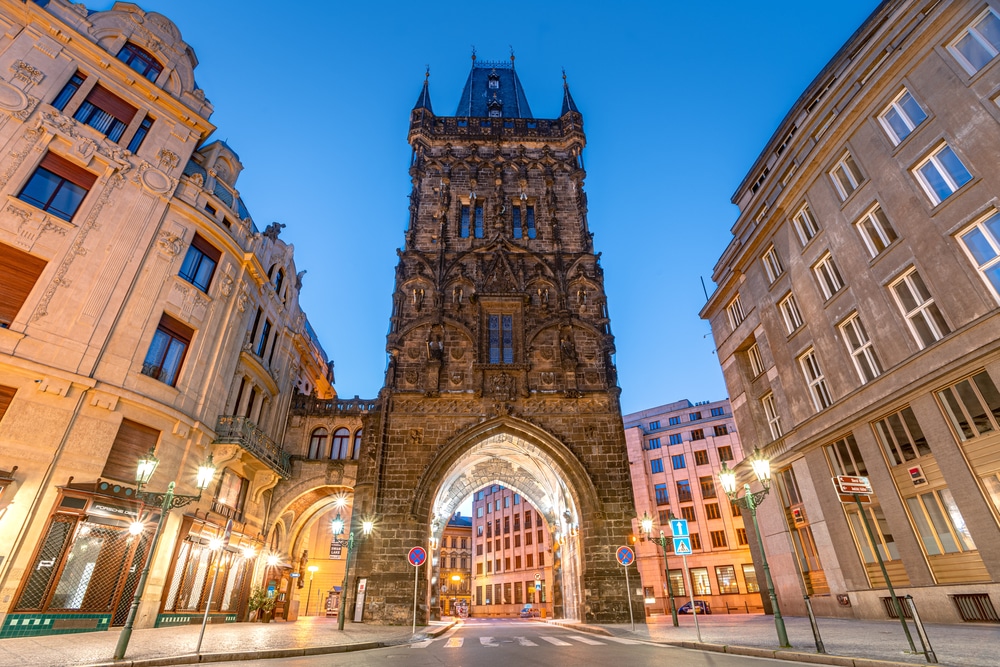 Source: Petr Svoboda / shutterstock
Source: Petr Svoboda / shutterstockThis emblematic landmark is one of Prague’s original 13 gates and marks the transition between the Old Town and New Town.
The foundation stone was laid by Vladislaus II of Hungary (1456-1516), while the name is much more recent as the gate served as a gunpowder depot from around the middle of the 18th century.
The design greeting visitors today is also relatively new, and goes back to the neo-Gothic revamp in the late-19th century by Czech architect Josef Mocher. The Powder Tower is the first step on the Royal Route, (Královská cesta) a tourist route leading to St Vitus Cathedral, following the course of a historic coronation trail taken by a long succession of Czech Kings.
You can go inside to see an exhibition about Prague’s skyline and enjoy the view 44 metres above the Old Town streets.
24. Vrtba Garden
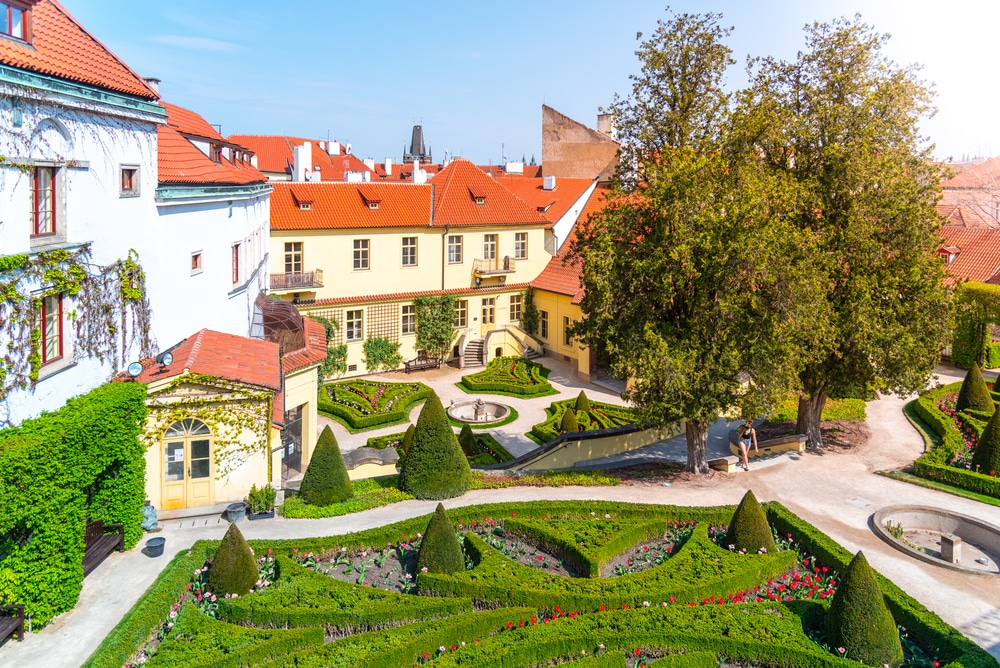 Source: Pyty / shutterstock
Source: Pyty / shutterstockThis dainty space is one of a cluster of Baroque gardens on the north slope of Petřín Hill, overlooking Malá Strana.
Vrtba Garden dates from a construction boom at the start of the 18th century and was designed by František Maxmilián Kaňka (1674-1766). At that time he was renovating the palace on the property, which has undergone lots of changes in the last couple of centuries, while the garden is mostly unaltered.
The garden is in a French formal style on three terraces, with topiaries and precise, scrolling boxwood broderies separated by gravel paths. The statues, urns and other sculptural elements on the balustrades were carved by Matthias Braun (1684-1738), the Czech region’s preeminent Baroque sculptor at the time.
There’s an unassuming entrance on Karmelitská Street, and the terraces give you what may be the best view of St Nicholas Church.
Website: https://www.vrtbovska.cz/
25. Kasárna Karlín
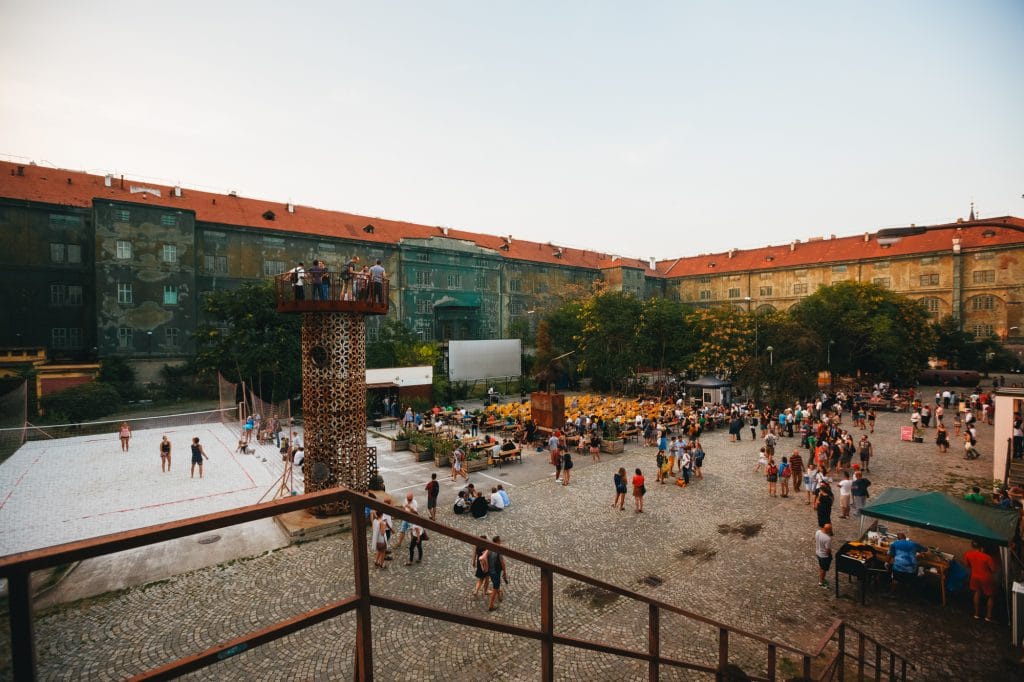 Source: Dorota Velek / Wikimedia | CC0
Source: Dorota Velek / Wikimedia | CC0A change of pace from Prague’s Baroque sights, Kasárna Karlín in Prague 8 was the site for the city’s military garrison from the 1840s until as recently as 2008.
The Neoclassical barracks building is enormous and remarkably close to the historic centre of Prague. By the 2000s the barracks had become obsolete, and after the various military units all moved out the Ministry of Defence welcomed proposals to revitalise the building.
These all fell through, until the non-profit Pražské centrum stepped in to turn it into a cultural centre. Kasárna Karlín started life in 2017 and may not be here forever. But there’s an endearing DIY quality to it all.
The tiled walls of the old army swimming pool now house a cafe, while the pool itself is a stage for theatre performances. There’s also a bar in the former vehicle garages, a sauna, lots of exhibition space, an indoor and outdoor cinema, a children’s playground and even a beach volleyball court in summer.
Website: https://kasarnakarlin.cz/